Drying and Wetting Trends and Vegetation Covariations in the Drylands of China
Abstract
:1. Introduction
2. Materials and Methods
2.1. Study Area
2.2. Land Cover Data
2.3. Meteorological Data
2.4. Drought Index
2.5. The GLEAM Soil Moisture
2.6. Normalized Difference Vegetation Index (NDVI)
2.7. Statistical Methods
3. Results
3.1. Spatial Patterns of Regional Climate and Vegetation
3.2. Regional Averaged Wetting and Drying Trends Calculated by Nine Dryness Indicators
3.3. Spatial Patterns of Drying and Wetting Trends by Means of Nine Dryness Indicators
3.4. Drought Area Variations
3.5. NDVI Co-Variations
4. Discussion
5. Conclusions
Author Contributions
Funding
Acknowledgments
Conflicts of Interest
References
- Heim, R.R. A review of twentieth-century drought indices used in the United States. Bull. Am. Meteorol. Soc. 2002, 83, 1149–1165. [Google Scholar] [CrossRef] [Green Version]
- Palmer, W.C. Meteorological Drought; United States Department of Commerce: Washington, DC, USA, 1965; p. 58.
- Wells, N.; Goddard, S.; Hayes, M.J. A self-calibrating Palmer drought severity index. J. Clim. 2004, 17, 2335–2351. [Google Scholar] [CrossRef]
- McKee, T.B.; Doesken, N.J.; Kleist, J. The Relationship of Drought Frequency and Duration to Time Scales. In Proceedings of the 8th Conference on Applied Climatology, Anaheim, CA, USA, 17–22 January 1993; pp. 179–186. [Google Scholar]
- Vicente-Serrano, S.M.; Beguería, S.; López-Moreno, J.I. A multiscalar drought index sensitive to global warming: The standardized precipitation evapotranspiration index. J. Clim. 2010, 23, 1696–1718. [Google Scholar] [CrossRef] [Green Version]
- Dai, A.G. Increasing drought under global warming in observations and models. Nat. Clim. Chang. 2013, 3, 52. [Google Scholar] [CrossRef]
- Sheffield, J.; Wood, E.F.; Roderick, M.L. Little change in global drought over the past 60 years. Nature 2012, 491, 435. [Google Scholar] [CrossRef] [PubMed]
- Thornthwaite, C.W. An approach toward a rational classification of climate. Geogr. Rev. 1948, 38, 55–94. [Google Scholar] [CrossRef]
- Monteith, J.L. Evaporation and environment. Symp. Soc. Exp. Biol. 1965, 19, 205–234. [Google Scholar] [PubMed]
- Dai, A.G. Characteristics and trends in various forms of the Palmer Drought Severity Index during 1900–2008. J. Geophys. Res. 2011, 116, D12115. [Google Scholar] [CrossRef] [Green Version]
- Vicente-Serrano, S.M.; Beguería, S.; López-Moreno, J.I. Comment on “Characteristics and trends in various forms of the Palmer Drought Severity Index (PDSI) during 1900–2008” by Aiguo Dai. J. Geophys. Res. 2011, 116, D19112. [Google Scholar] [CrossRef] [Green Version]
- Zhang, J.; Sun, F.; Xu, J.; Chen, Y.; Sang, Y.F.; Liu, C. Dependence of trends in and sensitivity of drought over China (1961–2013) on potential evaporation model. Geophys. Res. Lett. 2016, 43, 206–213. [Google Scholar] [CrossRef]
- Hao, Z.; Hao, F.; Singh, V.P. A general framework for multivariate multi-index drought prediction based on Multivariate Ensemble Streamflow Prediction (MESP). J. Hydrol. 2016, 539, 1–10. [Google Scholar] [CrossRef]
- Chen, T.; Zhang, H.; Chen, X.; Hagan, D.F.; Wang, G.; Gao, Z.; Shi, T. Robust drying and wetting trends found in regions over China based on Köppen climate classifications. J. Geophys. Res. Atmos. 2017, 122, 4228–4237. [Google Scholar] [CrossRef]
- Ma, Z. The interdecadal dry/wet trend and shift of North China and their relationship to the Pacific Decadal Oscillation (PDO). Chin. Sci. Bull. 2007, 52, 2130–2139. [Google Scholar] [CrossRef]
- Qi, J.G.; Chen, J.Q.; Wan, S.Q.; Ai, L.K. Understanding the coupled natural and human systems in DrylandsEast. Asia. Environ. Res. Lett. 2012, 7, 015202. [Google Scholar] [CrossRef] [Green Version]
- Qin, D.; Ding, Y.; Su, J.; Ren, J.; Wang, S.; Wu, R.; Yang, X.; Wang, S.; Liu, S.; Dong, G. Assessment of Climate and Environment Changes in China (І): Climate and environment changes in China and their projection. Adv. Clim. Chang. Res. 2005, 1, 6–11. [Google Scholar]
- Huang, J.; Yu, H.; Guan, X. Accelerated dryland expansion under climate change. Nat. Clim. Chang. 2016, 6, 166–171. [Google Scholar] [CrossRef]
- Shi, Y.; Shen, Y.; Kang, E.; Li, D.; Ding, Y.; Zhang, G.; Hu, R.J. Recent and future climate change in northwest China. Clim. Chang. 2007, 80, 379–393. [Google Scholar] [CrossRef]
- Chen, T.; Van der Werf, G.R.; De Jeu, R.A.; Wang, G.; Dolman, A.J. A global analysis of the impact of drought on net primary productivity. Hydrol. Earth Syst. Sci. 2013, 17, 3885–3894. [Google Scholar] [CrossRef] [Green Version]
- Zhou, G.; He, Q. Advance in the Study on Vulnerability Evaluation and Adaptation Management of Terrestrial Ecosystems. China Basic Sci. 2015, 17, 26–31. [Google Scholar]
- Huang, J.; Ji, M.; Liu, Y.; Zhang, L.; Gong, D. An overview of arid and semi-arid climate change. Adv. Clim. Chang. Res. 2013, 9, 9–14. [Google Scholar] [CrossRef]
- Liu, J.; Liu, M.; Zhuang, D.; Zhang, Z.; Deng, X. Study on spatial pattern of land-use change in China during 1995–2000. Sci. China Ser. D 2003, 46, 373–384. [Google Scholar]
- Liu, J.; Zhang, Z.; Zhuang, D.F.; Wang, Y.; Zhou, W.; Zhang, S.; Li, R.; Jiang, N.; Wu, S. A study on the spatial-temporal dynamic changes of land-use and driving forces analyses of China in the 1990s. Geogr. Res. 2003, 22, 1–12. [Google Scholar] [CrossRef]
- Liu, J.; Zhang, Z.; Xu, X.; Kuang, W.; Zhou, W.; Zhang, S.; Li, R.; Yan, C.; Yu, D.; Wu, S. Spatial patterns and driving forces of land use change in China during the early 21st century. J. Geogr. Sci. 2010, 20, 483–494. [Google Scholar] [CrossRef]
- Xu, Y.; Gao, X.; Shen, Y.; Xu, C.; Shi, Y.; Giorgi, F. A daily temperature dataset over China and its application in validating a RCM simulation. Adv. Atmos. Sci. 2009, 26, 763–772. [Google Scholar] [CrossRef]
- Zhao, T.; Fu, C. Comparison of products from ERA-40, NCEP-2, and CRU with station data for summer precipitation over China. Adv. Atmos. Sci. 2006, 23, 593–604. [Google Scholar] [CrossRef]
- Vicente-Serrano, S.; Beguería, S.; Lorenzo-Lacruz, J.; Camarero, J.; López-Moreno, J.I.; Azorin-Molina, C.; Revuelto, J.; Morán-Tejeda, E.; Sanchez-Lorenzo, A. Performance of Drought Indices for Ecological, Agricultural, and Hydrological Applications. Earth Interact. 2012, 16, 1–27. [Google Scholar] [CrossRef] [Green Version]
- Paulo, A.A.; Rosa, R.D.; Pereira, L.S. Climate trends and behaviour of drought indices based on precipitation and evapotranspiration in Portugal. Nat. Hazards Earth Syst. Sci. 2012, 12, 1481–1491. [Google Scholar] [CrossRef]
- Wang, W.; Zhu, Y.; Xu, R.; Liu, J. Drought severity change in China during 1961–2012 indicated by SPI and SPEI. Nat. Hazards Earth Syst. Sci. 2015, 75, 2437–2451. [Google Scholar] [CrossRef]
- Dai, A. Drought under global warming: A review. Wiley Interdiscip. Rev. Clim. Chang. 2011, 2, 45–65. [Google Scholar] [CrossRef] [Green Version]
- Beguería, S.; Vicente-Serrano, S.M.; Reig, F.; Latorre, B. Standardized precipitation evapotranspiration index (SPEI) revisited: Parameter fitting, evapotranspiration models, tools, datasets and drought monitoring. Int. J. Climatol. 2014, 34, 3001–3023. [Google Scholar] [CrossRef] [Green Version]
- Ficklin, D.L.; Maxwell, J.T.; Letsinger, S.L.; Gholizadeh, H. A climatic deconstruction of recent drought trends in the United States. Environ. Res. Lett. 2015, 10, 044009. [Google Scholar] [CrossRef]
- Sheffield, J.; Goteti, G.; Wood, E.F. Development of a 50-yr high-resolution global dataset of meteorological forcings for land surface modeling. J. Clim. 2006, 19, 3088–3111. [Google Scholar] [CrossRef] [Green Version]
- Miralles, D.; Holmes, T.; De Jeu, R.; Gash, J.; Meesters, A.; Dolman, A. Global land-surface evaporation estimated from satellite-based observations. Hydrol. Earth. Syst. Sci. 2011, 15, 453–469. [Google Scholar] [CrossRef] [Green Version]
- Nemani, R.R.; Keeling, C.D.; Hashimoto, H.; Jolly, W.M.; Piper, S.C.; Tucker, C.J.; Myneni, R.B.; Running, S.W. Climate-Driven Increases in Global Terrestrial Net Primary Production from 1982 to 1999. Science 2003, 300, 1560. [Google Scholar] [CrossRef] [Green Version]
- Piao, S.; Wang, X.; Ciais, P.; Zhu, B.; Wang, T.A.O.; Liu, J.I.E. Changes in satellite-derived vegetation growth trend in temperate and boreal Eurasia from 1982 to 2006. Glob. Chang. Biol. 2011, 17, 3228–3239. [Google Scholar] [CrossRef]
- Beck, H.E.; McVicar, T.R.; van Dijk, A.I.; Schellekens, J.; de Jeu, R.A.; Bruijnzeel, L.A. Global evaluation of four AVHRR–NDVI data sets: Intercomparison and assessment against Landsat imagery. Remote Sens. Environ. 2011, 115, 2547–2563. [Google Scholar] [CrossRef]
- Tucker, C.J.; Pinzon, J.E.; Brown, M.E.; Slayback, D.A.; Pak, E.W.; Mahoney, R.; Vermote, E.F.; El Saleous, N.J. An extended AVHRR 8-km NDVI dataset compatible with MODIS and SPOT vegetation NDVI data. Int. J. Remote Sens. 2005, 26, 4485–4498. [Google Scholar] [CrossRef]
- Mann, H.B. Nonparametric Tests against Trend. Econometrica 1945, 13, 245–259. [Google Scholar] [CrossRef]
- Kendall, K. Thin-film peeling-the elastic term. J. Phys. D Appl. Phys. 1975, 8, 1449–1452. [Google Scholar] [CrossRef]
- Ren, J.; Liu, H.; Yin, Y.; He, S. Drivers of greening trend across vertically distributed biomes in temperate arid Asia. Geophys. Res. Lett. 2007, 34. [Google Scholar] [CrossRef]
- Zhao, X.; Tan, K.; Zhao, S.; Fang, J. Changing climate affects vegetation growth in the arid region of the northwestern China. J. Arid Environ. 2011, 75, 946–952. [Google Scholar] [CrossRef]
- Kim, D.W.; Byun, H.R.; Choi, K.S. Evaluation, modification, and application of the Effective Drought Index to 200-Year drought climatology of Seoul, Korea. J. Hydrol. 2009, 378, 1–12. [Google Scholar] [CrossRef]
- Zhang, X.; Li, M.; Ma, Z.; Yang, Q.; Lv, M.; Clark, R. Assessment of an evapotranspiration deficit drought index in relation to impacts on ecosystems. Adv. Atmos. Sci. 2019, 36, 1273–1287. [Google Scholar] [CrossRef]
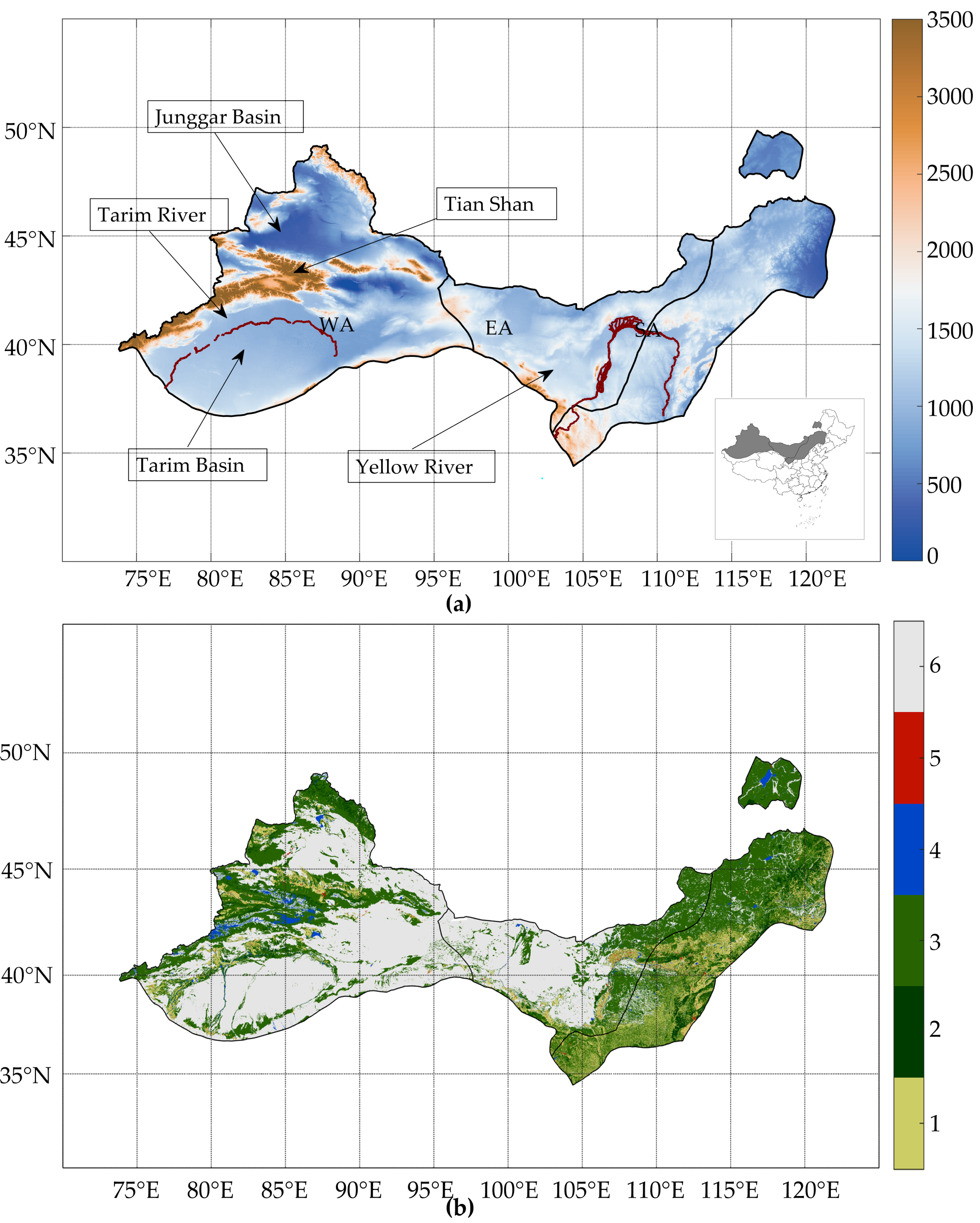
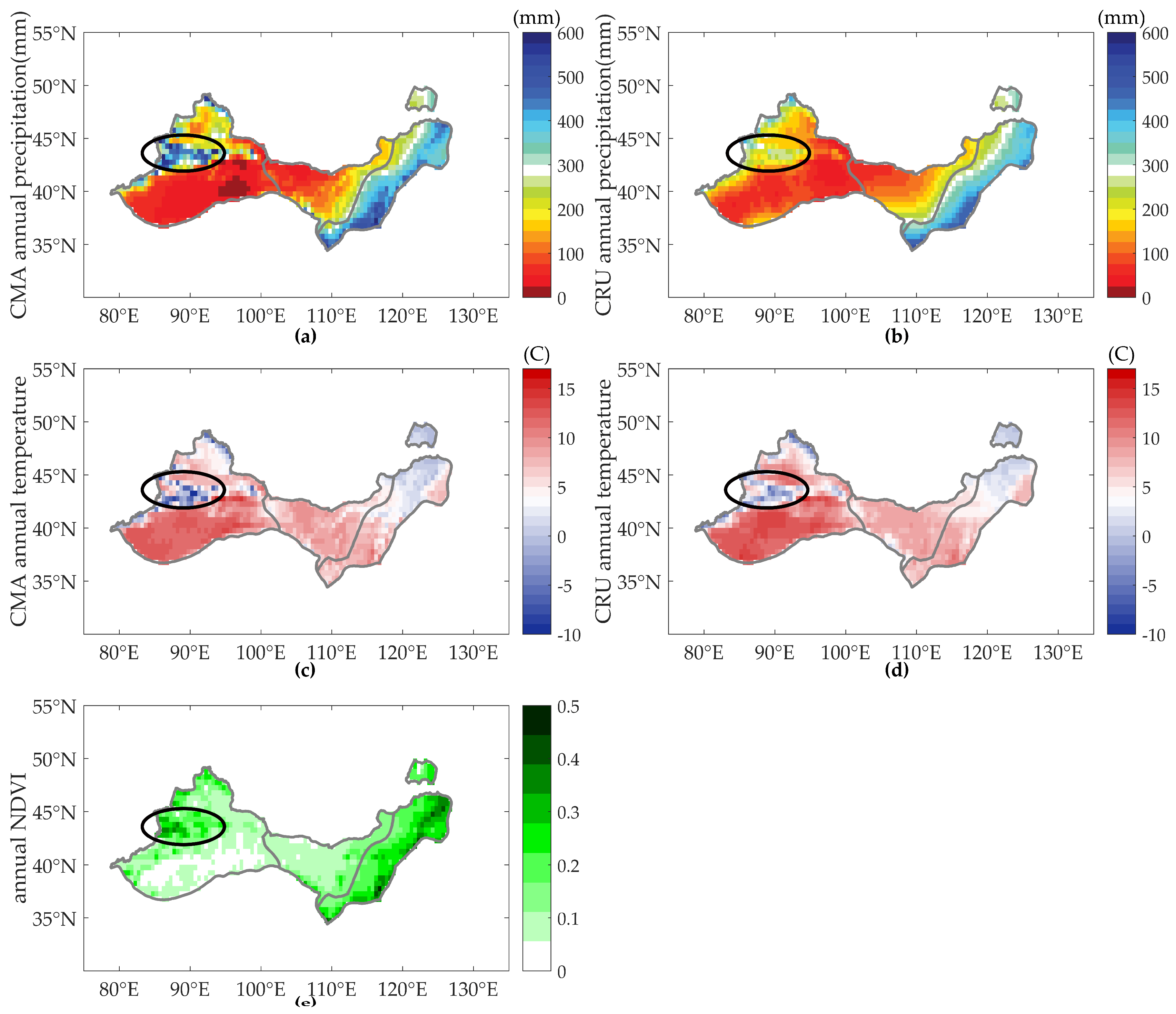
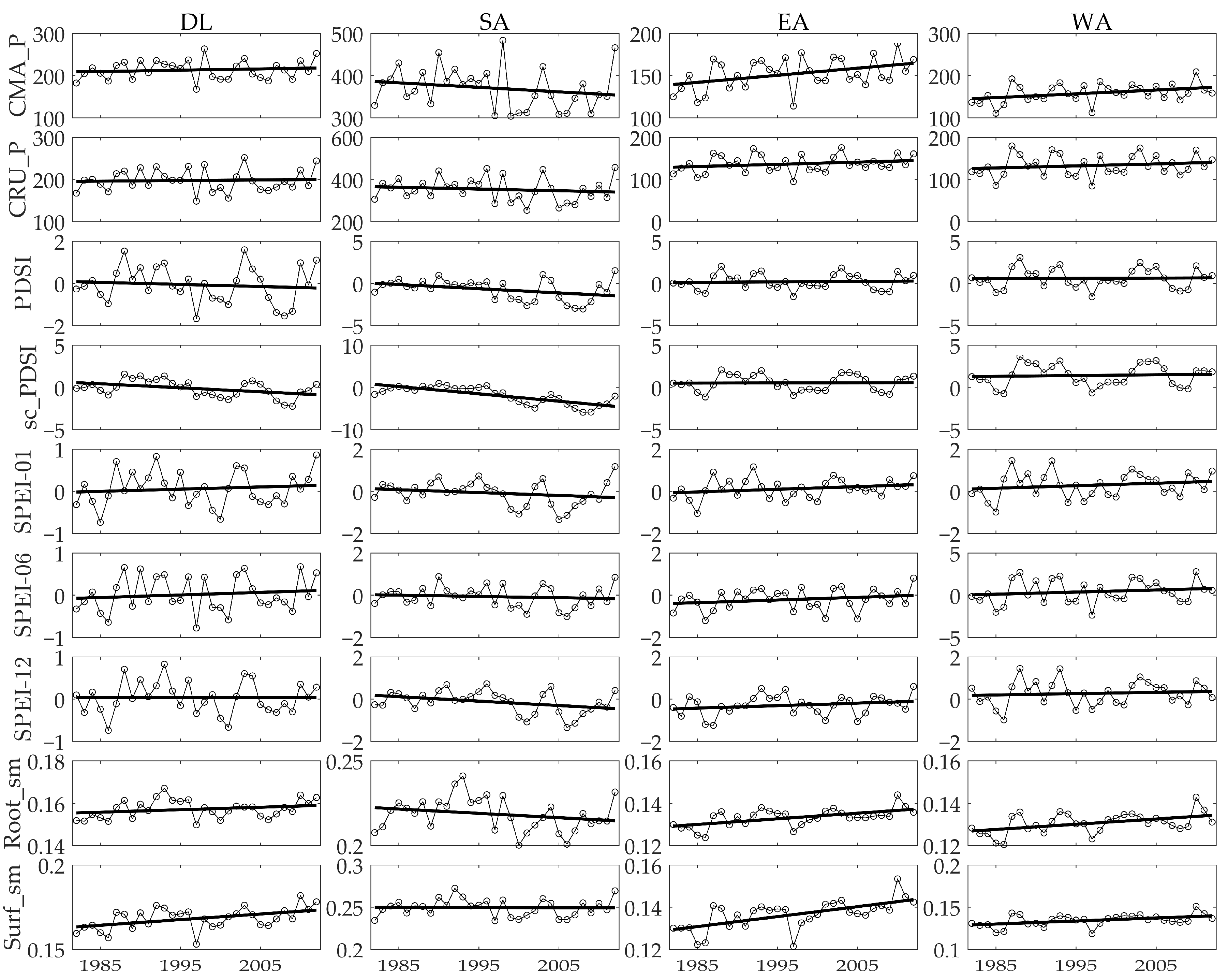
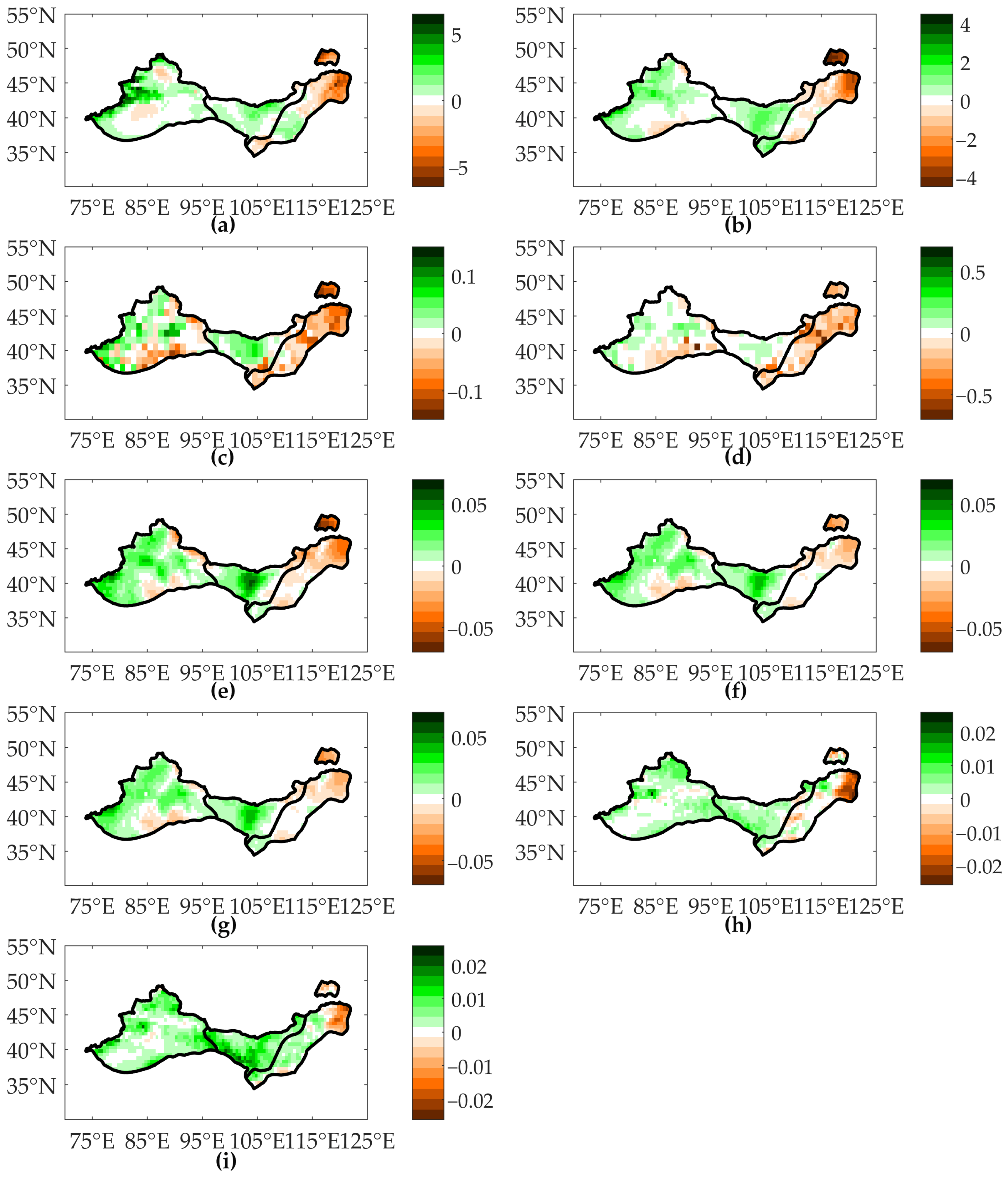
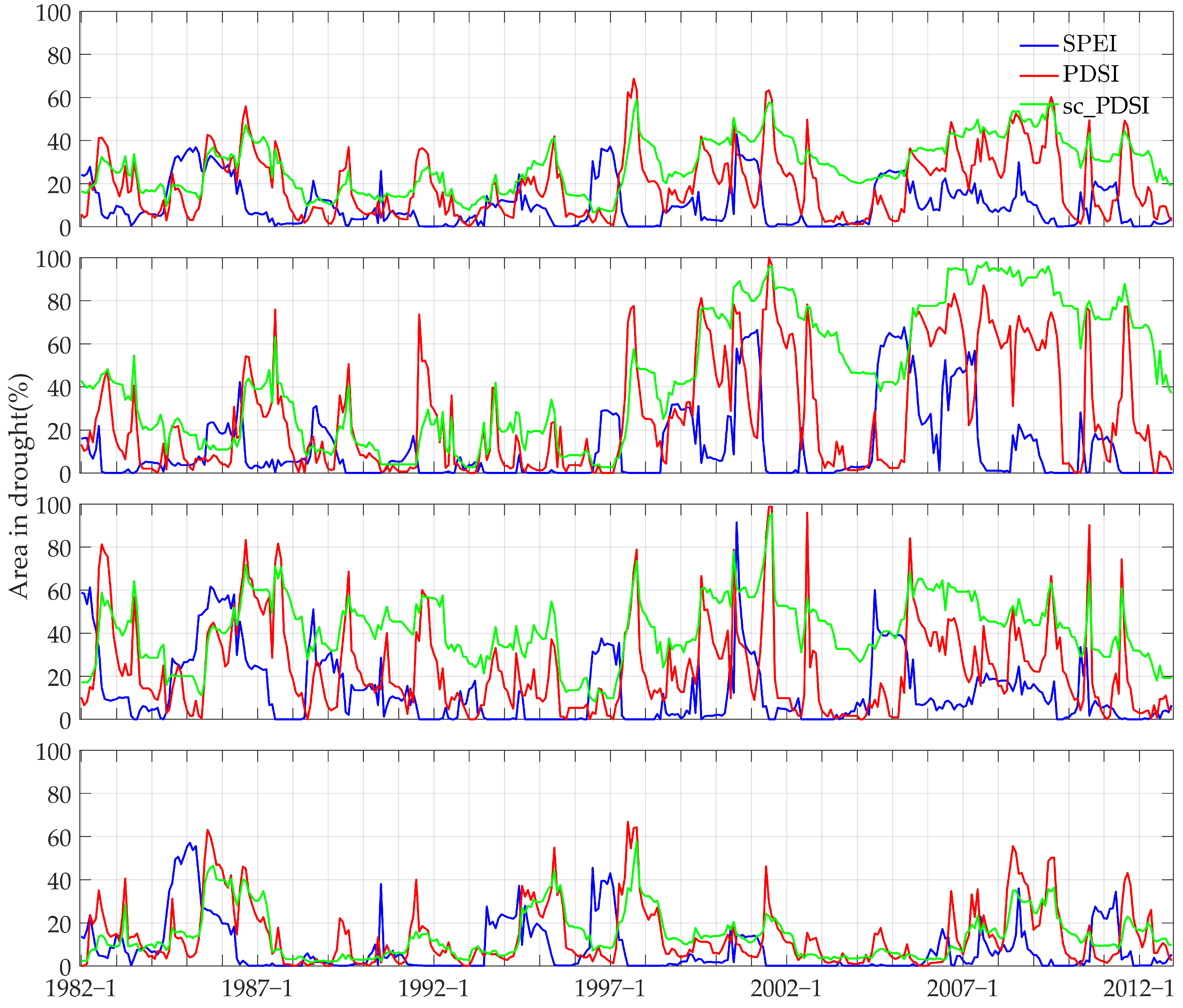
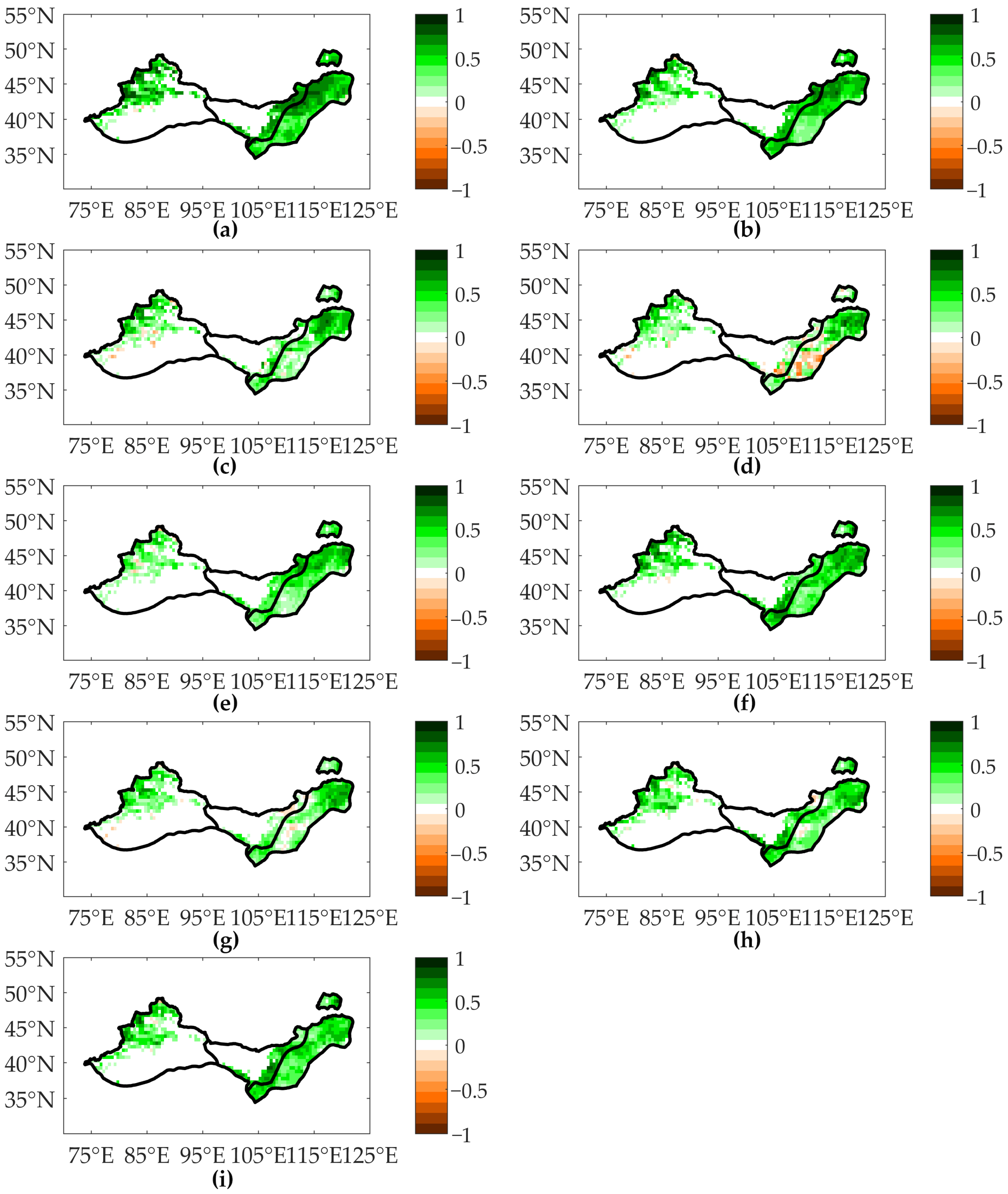
| Class # | Class Name | % |
|---|---|---|
| 1 | Cropland, including paddy and dry fields | 9.58 |
| 2 | Woodland, including natural and economic woodland | 4.00 |
| 3 | Grassland with a coverage >5% | 36.47 |
| 4 | Water body, including natural land waters and land for water conservancy facilities | 1.68 |
| 5 | Build-up land | 0.70 |
| 6 | Unused land | 47.34 |
| Dryland | Semi-Arid | Eastern-Arid | Western-Arid | |
|---|---|---|---|---|
| Annual | ||||
| CMA_P | 0.304 | −1.064 | 0.840 * | 0.902 * |
| CRU_P | 0.143 | −0.834 | 0.526 | 0.476 |
| PDSI | −0.010 | −0.050 * | 0.006 | 0.002 |
| sc_PDSI | −0.048 * | −0.174 * | 0.002 | 0.008 |
| SPEI-01 | 0.005 | −0.014 | 0.013 | 0.012 |
| SPEI-06 | 0.006 | −0.006 | 0.013 | 0.010 |
| SPEI-12 | −0.002 | −0.021 * | 0.012 | 0.006 |
| Root_sm | 0.119 | −0.257 | 0.266 * | 0.248 * |
| Surf_sm | 0.332 * | −0.024 | 0.472 * | 0.359 * |
| Growing Season | ||||
| CMA_P | −0.091 | −1.416 | 0.427 | 0.336 |
| CRU_P | −0.169 | −1.111 | 0.200 | 0.013 |
| PDSI | −0.018 | −0.065 * | −0.000 | 0.004 |
| sc_PDSI | −0.051 * | −0.178 * | −0.002 | 0.005 |
| SPEI-01 | 0.006 | −0.012 | 0.013 | 0.013 |
| SPEI-06 | −0.001 | −0.010 | −0.000 | 0.003 |
| SPEI-12 | 0.000 | −0.019 | 0.012 | 0.006 |
| Root_sm | 0.001 | −0.359 | 0.138 * | 0.139 * |
| Surf_sm | 0.067 | −0.395 | 0.248 * | 0.221 * |
| Dryland | Semi-Arid | Eastern-Arid | Western-Arid | |
|---|---|---|---|---|
| O-S | ||||
| CMA_P | 0.624 * | 0.651 * | 0.371 * | 0.665 * |
| CRU_P | 0.549 * | 0.621 * | 0.264 | 0.523 * |
| PDSI | 0.369 * | 0.463 * | 0.058 | 0.467 * |
| sc_PDSI | 0.055 | 0.096 | −0.300 | 0.470 * |
| SPEI-01 | 0.339 * | 0.449 * | 0.128 | 0.222 |
| SPEI-06 | 0.621 * | 0.681 * | 0.361 * | 0.589 * |
| SPEI-12 | 0.475 * | 0.463 * | 0.200 | 0.595 * |
| Surf_sm | 0.572 * | 0.575 * | 0.501 * | 0.577 * |
| Root_sm | 0.419 * | 0.397 * | 0.338 * | 0.581 * |
| Growing Season (M-S) | ||||
| CMA_P | 0.558 * | 0.636 * | 0.389 * | 0.547 * |
| CRU_P | 0.521 * | 0.646 * | 0.292 | 0.316 * |
| PDSI | 0.418 * | 0.552 * | 0.137 | 0.431 * |
| sc_PDSI | 0.121 | 0.167 | −0.197 | 0.466 * |
| SPEI-01 | 0.181 | 0.316 * | −0.005 | 0.063 |
| SPEI-06 | 0.539 * | 0.659 * | 0.267 | 0.476 * |
| SPEI-12 | 0.552 * | 0.593 * | 0.286 | 0.585 * |
| Surf_sm | 0.537 * | 0.598 * | 0.371 * | 0.634 * |
| Root_sm | 0.585 * | 0.627 * | 0.406 * | 0.696 * |
| CMA_P | CRU_P | SPEI-01 | PDSI | sc_PDSI | Root_sm | Surf_sm | |
|---|---|---|---|---|---|---|---|
| Semi-Arid | |||||||
| CMA_P | 1.000 | 0.897 * | 0.635 * | 0.752 * | 0.477 * | 0.740 * | 0.849 * |
| CRU_P | 0.897 * | 1.000 | 0.676 * | 0.809 * | 0.443 * | 0.649 * | 0.806 * |
| SPEI-01 | 0.635 * | 0.676 * | 1.000 | 0.653 * | 0.424 * | 0.537 * | 0.613 * |
| PDSI | 0.752 * | 0.809 * | 0.653 * | 1.000 | 0.722 * | 0.669 * | 0.702 * |
| sc_PDSI | 0.477 * | 0.443 * | 0.424 * | 0.722 * | 1.000 | 0.584 * | 0.360 * |
| Root_sm | 0.740 * | 0.649 * | 0.537 * | 0.669 * | 0.584 * | 1.000 | 0.852 * |
| Surf_sm | 0.849 * | 0.806 * | 0.613 * | 0.702 * | 0.360 * | 0.852 * | 1.000 |
| Eastern-Arid | |||||||
| CMA_P | 1.000 | 0.862 * | 0.407 * | 0.621 * | 0.394 * | 0.757 * | 0.799 * |
| CRU_P | 0.862 * | 1.000 | 0.568 * | 0.818 * | 0.604 * | 0.598 * | 0.673 * |
| SPEI-01 | 0.407 * | 0.568 * | 1.000 | 0.419 * | 0.315 * | 0.373 * | 0.430 * |
| PDSI | 0.621 * | 0.818 * | 0.419 * | 1.000 | 0.885 * | 0.590 * | 0.588 * |
| sc_PDSI | 0.394 * | 0.604 * | 0.315 * | 0.885 * | 1.000 | 0.475 * | 0.433 * |
| Root_sm | 0.757 * | 0.598 * | 0.373 * | 0.590 * | 0.475 * | 1.000 | 0.964 * |
| Surf_sm | 0.799 * | 0.673 * | 0.430 * | 0.588 * | 0.433 * | 0.964 * | 1.000 |
| Western-arid | |||||||
| CMA_P | 1.000 | 0.853 * | 0.418 * | 0.655 * | 0.428 * | 0.774 * | 0.832 * |
| CRU_P | 0.853 * | 1.000 | 0.601 * | 0.848 * | 0.628 * | 0.617 * | 0.705 * |
| SPEI-01 | 0.418 * | 0.601 * | 1.000 | 0.450 * | 0.350 * | 0.284 | 0.360 * |
| PDSI | 0.655 * | 0.848 * | 0.450 * | 1.000 | 0.881 * | 0.688 * | 0.716 * |
| sc_PDSI | 0.428 * | 0.628 * | 0.350 * | 0.881 * | 1.000 | 0.586 * | 0.558 * |
| Root_sm | 0.774 * | 0.617 * | 0.284 | 0.688 * | 0.586 * | 1.000 | 0.967 * |
| Surf_sm | 0.832 * | 0.705 * | 0.360 * | 0.716 * | 0.558 * | 0.967 * | 1.000 |
© 2020 by the authors. Licensee MDPI, Basel, Switzerland. This article is an open access article distributed under the terms and conditions of the Creative Commons Attribution (CC BY) license (http://creativecommons.org/licenses/by/4.0/).
Share and Cite
Liang, C.; Chen, T.; Dolman, H.; Shi, T.; Wei, X.; Xu, J.; Hagan, D.F.T. Drying and Wetting Trends and Vegetation Covariations in the Drylands of China. Water 2020, 12, 933. https://doi.org/10.3390/w12040933
Liang C, Chen T, Dolman H, Shi T, Wei X, Xu J, Hagan DFT. Drying and Wetting Trends and Vegetation Covariations in the Drylands of China. Water. 2020; 12(4):933. https://doi.org/10.3390/w12040933
Chicago/Turabian StyleLiang, Chuanzhuang, Tiexi Chen, Han Dolman, Tingting Shi, Xueqiong Wei, Jialu Xu, and Daniel Fiifi Tawia Hagan. 2020. "Drying and Wetting Trends and Vegetation Covariations in the Drylands of China" Water 12, no. 4: 933. https://doi.org/10.3390/w12040933






